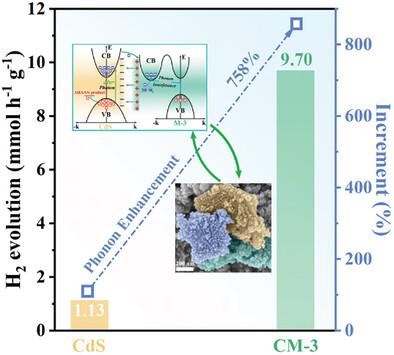Optimization of CdS/MoS2 Photocatalysts for Phonon-Enhanced H2 Evolution via Indirect Transition Modulation in Layer-Dependent MoS2
IF 13
2区 材料科学
Q1 CHEMISTRY, MULTIDISCIPLINARY
引用次数: 0
Abstract
Rational modulation in the transition distribution of electronic band structure is crucial for constructing phonon-induced enhancement effects for efficient charge separation and thus improving the photocatalytic activity of heterogeneous semiconductor systems. Herein, the indirect/direct transition modulation of layer-dependent MoS2 has been systematically investigated and modeled as a noble metal-free cocatalyst model to study the spatial behavior of carriers in the presence of the phonon effect by coupling it to the direct semiconductor CdS. Consequently, photocarrier separation at the heterojunction interface is greatly facilitated by the optimized band-matching mechanism, while phonon-interfered recombination achieves lifetime extension, which is further elucidated by theoretical simulations. Notably, the water reduction properties of the optimal CdS/MoS2 system exhibit a striking apparent quantum efficiency (31.33% at 380 nm), with an H2 evolution rate as high as 9.70 mmol h−1 g−1, which is 7.58 times higher than that of pristine CdS. Overall, this work demonstrates the capability of involved phonons for enhancing charge transfer dynamics, and provides great flexibility for precisely designing superior photocatalytic systems by manipulating the electronic band transformation.

基于层相关MoS2间接跃迁调制的CdS/MoS2光催化剂的优化
合理调制电子能带结构的跃迁分布对于构建声子诱导的高效电荷分离增强效应,从而提高非均相半导体体系的光催化活性至关重要。本文系统地研究了层相关MoS2的间接/直接跃迁调制,并将其建模为无贵金属助催化剂模型,通过将其耦合到直接半导体CdS上,研究了声子效应存在下载流子的空间行为。因此,优化的带匹配机制极大地促进了异质结界面的光载流子分离,而声子干涉复合实现了寿命延长,理论模拟进一步证实了这一点。值得注意的是,优化后的CdS/MoS2体系在380 nm处表现出了惊人的量子效率(31.33%),H2的析出速率高达9.70 mmol h−1 g−1,是原始CdS的7.58倍。总的来说,这项工作证明了参与声子增强电荷转移动力学的能力,并通过操纵电子能带变换为精确设计优越的光催化系统提供了很大的灵活性。
本文章由计算机程序翻译,如有差异,请以英文原文为准。
求助全文
约1分钟内获得全文
求助全文
来源期刊

Small
工程技术-材料科学:综合
CiteScore
17.70
自引率
3.80%
发文量
1830
审稿时长
2.1 months
期刊介绍:
Small serves as an exceptional platform for both experimental and theoretical studies in fundamental and applied interdisciplinary research at the nano- and microscale. The journal offers a compelling mix of peer-reviewed Research Articles, Reviews, Perspectives, and Comments.
With a remarkable 2022 Journal Impact Factor of 13.3 (Journal Citation Reports from Clarivate Analytics, 2023), Small remains among the top multidisciplinary journals, covering a wide range of topics at the interface of materials science, chemistry, physics, engineering, medicine, and biology.
Small's readership includes biochemists, biologists, biomedical scientists, chemists, engineers, information technologists, materials scientists, physicists, and theoreticians alike.
 求助内容:
求助内容: 应助结果提醒方式:
应助结果提醒方式:


